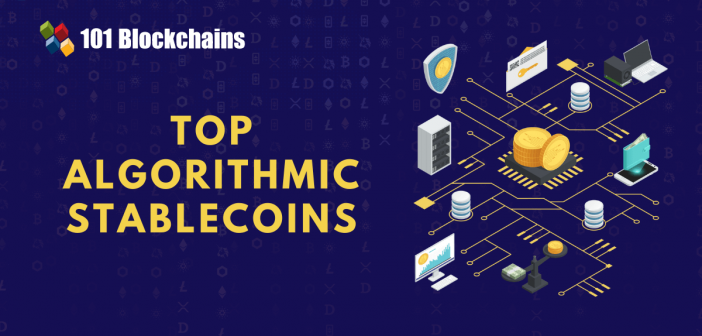Master stability in a volatile world — unlock the power of stablecoins to navigate crypto with confidence. Explore real-world use cases in the Stablecoins Mastery course.

- Cryptocurrency
Georgia Weston
- on July 01, 2022
List of Top 5 Algorithmic Stablecoins
The advocacy for DeFi in the new crypto trends has been gaining considerable levels of attention in recent times. At this point in time, the discussion on an algorithmic stablecoins list is quite relevant, considering the ways in which they can draw in more users. Cryptocurrencies have always been associated with a highly volatile nature, associated with different factors such as market conditions and supply-demand dynamics.
On the other hand, stablecoins have changed the game completely by introducing a stable variant of cryptocurrencies. Are stablecoins truly stable? What is the role of algorithmic stablecoins in the future of crypto? The following discussion helps you identify the top five algorithmic stablecoins along with an overview of risks associated with them.
Want to learn the basic and advanced concepts of Stablecoin? Enroll Now in Stablecoin Fundamentals Masterclass
Understanding Algorithmic Stablecoins
The first step in learning about the best algorithmic stablecoins right now would refer to an understanding of their definition. What are algorithmic stablecoins, and how do they work? It is important to note that algorithmic stablecoins do not have any associations with collateral. Therefore, the algorithmic stablecoins are also known as ‘non-collateralized’ stablecoins. Algorithmic stablecoins are decentralized and focus on improving market price stability through pre-programmed supply for matching asset demand. Algorithmic stablecoins employ predefined stabilization measures encoded in the different smart contracts on Ethereum.
The algorithm behind the top algorithmic stablecoins features the necessary programming for increasing the supply of a cryptocurrency in deflationary positions. On the other hand, it also works to decrease the supply of stablecoin in situations involving a substantial reduction in purchasing power. As a result, algorithmic stablecoins could respond to different market events with automated stabilization measures.
The design of algorithmic stablecoins shows them as a decentralized, smart, and responsive cryptocurrencies. Algorithmic stablecoins can maintain transparency over the network by offering visibility into their internal logic. They can also provide details of the collateral used in maintaining token value.
Excited to learn the basic and advanced concepts of ethereum technology? Enroll Now in The Complete Ethereum Technology Course
Working of Algorithmic Details
Another important highlight before the list of algorithmic stablecoins must focus on the working of algorithmic stablecoins. Algorithmic stablecoins help in stabilizing the market by leveraging the mechanisms for purchasing and selling the concerned asset or derivatives. Generally, algorithmic stablecoins use Ethereum-based crypto protocols for issuing coins in event of a price surge. The protocol also responds by purchasing coins from the market in event of a price drop. You can develop a clear impression of the working of algorithmic stablecoins with the simple steps as follows.
-
Oracle Contract
The oracle contact help in communication between the smart contract and external channels beyond blockchain. Oracle contracts work on obtaining price of the algorithmic stablecoin on different exchanges.
-
Rebase Contract
The rebase contract is the next important highlight in the working of algorithmic stablecoins examples as it takes the stablecoin price from different exchanges as the input. Rebase contract helps in determining whether the stablecoin supply must be reduced or increased.
-
Burning or Minting Tokens
The rebase contract would evaluate the number of tokens it must burn or mint from the wallet of users. The primary logic underlying the contract states that a rise in the value of the coin from the stable value would trigger the algorithm for burning tokens. On the other hand, the reduction of the token price below the stable value results in the algorithm minting new tokens.
Build your identity as a certified blockchain expert with 101 Blockchains’ Blockchain Certifications designed to provide enhanced career prospects.
Types of Algorithmic Stablecoins
The outline of popular algorithmic stablecoins should always be associated with an overview of the types of algorithmic stablecoins. You can discover different algorithmic stablecoins with unique traits or features. Here is an outline of the distinct types of algorithmic stablecoins you should look out for.
-
Rebasing Algorithmic Stablecoins
The rebasing algorithmic stablecoins basically involve the supply taking over regulation of value. In this case, the algorithm reduces the coin supply in event of a price drop and ensures issuing additional coins in the opposite situation.
-
Over-collateralized Algorithmic Stablecoins
The over-collateralized algorithmic stablecoins depend on a large reserve of cryptocurrencies for issuing lesser stablecoins. Such types of algorithmic stablecoins serve as an effective choice for a buffer for price fluctuations.
-
Fractional Algorithmic Stablecoins
Fractional algorithmic stablecoins are one of the important additions to an algorithmic stablecoins list, and they are partially collateralized. The assets feature backing of cryptographic algorithms as well as asset collateralization.
-
Seigniorage Algorithmic Stablecoins
The Seigniorage algorithmic stablecoin model opts for an alternative to the rebasing mechanism. It features two distinct tokens such as a supply-elastic currency and the investment shares of the network. The owners of the investment shares can receive inflationary rewards and bear the burden of debt when the currency falls.
Want to become a Cryptocurrency expert? Enroll Now in Cryptocurrency Fundamentals Course
Top Algorithmic Stablecoins
The overview of the definition, working, and types of algorithmic stablecoins provide a solid foundation for exploring different algorithmic stablecoins. However, it is important to be careful of risks associated with the best algorithmic stablecoins, especially considering the example of TerraUSD.
At one point in time, the TerraUSD algorithmic stablecoin assumed the third position among stablecoins in terms of market capitalization. On the other hand, the stablecoin value was reduced to almost 30 cents, thereby creating doubts regarding their feasibility. What are some of the top options among popular algorithmic stablecoins which wouldn’t follow the route of TerraUSD? Here are some answers you might take into account.
1. DAI

The first and foremost choice among algorithmic stablecoins right now would point at DAI. It is an effective Ethereum-based stablecoin in the list of algorithmic stablecoins available in the market right now. The Maker Protocol, alongside the MakerDAO decentralized autonomous organization, serves a crucial role in issuing and developing DAI.
Therefore, it fits the automated and decentralized model associated frequently with algorithmic stablecoins. The soft-pegging of the price of DAI against the US dollar is a clear advantage for users. At the same time, DAI also has the backing of collateral featuring a mix of many different cryptocurrencies.
2. Frax

The next popular entry among algorithmic stablecoins examples which can be better than TerraUSD includes Frax. As a matter of fact, the Frax Protocol is one of the first algorithmic stablecoin processes and systems. It works as an open-source and permissionless cryptocurrency available completely in the on-chain mode on Ethereum blockchain.
The primary goal of the Frax protocol focuses prominently on highly decentralized, algorithmic, and scalable stablecoin. As one of the top algorithmic stablecoins, Frax looks forward to serving the DeFi money market. It can offer effective services such as minting and redeeming the stablecoin alongside staking. Interestingly, the Frax protocol uses two different stable assets, such as the Frax stablecoin alongside the Frax Shares utility and governance token.
Want to learn and understand the scope and purpose of DeFi? Enroll Now in Introduction to Defi- Decentralized Finance Course
3. Ampleforth

The third addition among the best algorithmic stablecoins would refer to Ampleforth. It is an Ethereum-based cryptocurrency that follows the model of regulations in circulating supply through adjustments in algorithms. Ampleforth has been tailored for serving as the base money in the modern decentralized economy. How? It could offer an asset that is not subject to dilution in event of supply inflation. On top of it, the algorithmic stablecoin also stays decoupled from the price volatility with other cryptocurrencies such as Bitcoin.
You can think of Ampleforth as one of the perfect decentralized stablecoins, which leverage a flexible supply for maintaining price stability. It is an interesting entry among popular algorithmic stablecoins in the rebasing stablecoins category. The rebasing mechanism helps in regular adjustments in the supply of Ampleforth stablecoin. Thus, it can guarantee improved price stability in comparison to fixed-supply cryptocurrencies. Most important of all, the stablecoin of Ampleforth, AMPL, is completely non-dilutive and elastic.
4. Empty Set Dollar

The Empty Set Dollar or ESD is another notable example among top algorithmic stablecoins offering the combination of multiple advantages. ESD serves a combination of new protocol mechanisms, composability, and decentralization. As a result, it is an effective contender from an algorithmic stablecoins list for the DeFi sector.
ESD serves as an effectively decentralized, oracle-oriented stablecoin with new protocol mechanisms for resolving the concerns with rebasing algorithmic stablecoins. Token holders have the privilege of avoiding the necessity of actively maintaining the price peg by using it in dApps. In addition, you can also use it as a stablecoin without committing funds to a centralized provider.
5. Magic Internet Money

Another interesting entry in the list of algorithmic stablecoins you should try now is Magic Internet Money. It is one of the notable algorithmic stablecoins you can find on popular crypto exchanges such as Curve Finance, Uniswap, and PancakeSwap. The platform allows users to deposit their interest-bearing assets on Magic Internet Money and use them as collateral for borrowing the stablecoin.
Start learning about Cryptocurrencies with World’s first Cryptocurrency Skill Path with quality resources tailored by industry experts Now!
Bottom Line
The overview of the top algorithmic stablecoins in this list shows the importance of leveraging new technologies for crypto adoption. As the application of stablecoins in DeFi continues to rise, algorithmic stablecoins can bring multiple value benefits for users. The top choices in algorithmic stablecoins are not the only options you have at your disposal right now.
On the contrary, you can seek many other alternatives among algorithmic stablecoins according to your specific requirements. Most important of all, you must employ in-depth research on a specific algorithmic stablecoin before investing in it. The mechanisms for balancing supply and demand can be quite confusing for beginners. Keep learning about algorithmic stablecoins and how they can deliver value for the future of crypto.
*Disclaimer: The article should not be taken as, and is not intended to provide any investment advice. Claims made in this article do not constitute investment advice and should not be taken as such. 101 Blockchains shall not be responsible for any loss sustained by any person who relies on this article. Do your own research!





